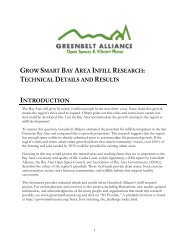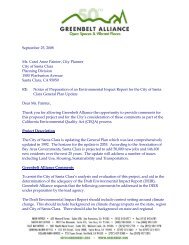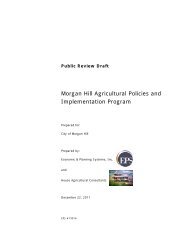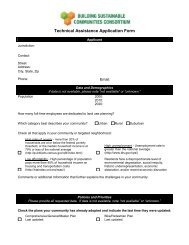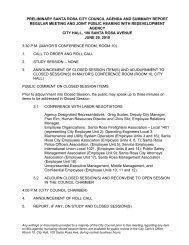Create successful ePaper yourself
Turn your PDF publications into a flip-book with our unique Google optimized e-Paper software.
Alameda County<br />
County progress, Tri-Valley pressure<br />
General Assessment<br />
Alameda County has made significant<br />
progress in securing its greenbelt, but<br />
challenges remain. The 2000 elections<br />
in particular were a landmark<br />
in the county’s land-use history, with<br />
voters passing crucial greenbelt<br />
protection measures. Going forward,<br />
more responsible city policies will be<br />
needed, as well as continued vigilance<br />
against developer-backed attempts to<br />
roll back growth limits.<br />
Hot Spots<br />
The east county cities of Livermore,<br />
Pleasanton, and Dublin remain the<br />
focus of land-use controversies in<br />
Alameda County. Virtually all of the<br />
county’s 15,000 acres that remain at<br />
high risk are around these cities. The<br />
flat ranchlands north of Livermore<br />
remain a prime target of developers,<br />
despite an urban growth boundary<br />
protecting the area. Developer Pardee<br />
Homes placed an initiative on the<br />
2005 ballot to allow 2,450 houses on<br />
1,500 acres of the land, but failed<br />
thanks to the concerted efforts of<br />
local activists. Despite the progress<br />
made in recent years, the growth<br />
pressures in these Tri-Valley cities<br />
could still increase Alameda County’s<br />
total urbanized area by more than<br />
10% in just the next 10 years.<br />
Bright Spots<br />
The passage of Measure D by county<br />
voters in 2000 laid down a key<br />
cornerstone for long-term greenbelt<br />
protection in Alameda County. The<br />
measure established a county urban<br />
growth boundary, prohibited subdivision<br />
of ranchlands in the east county,<br />
and encouraged investment in<br />
existing urbanized areas, extending<br />
regulatory protection to as much as<br />
150,000 acres of farm, ranch and<br />
habitat lands. In the same election,<br />
Dublin voters passed Measure M to<br />
protect 4,000 acres of hill country,<br />
and county voters overwhelmingly<br />
passed the transit-friendly transportation<br />
sales tax Measure B.<br />
Progress continued in 2002, when<br />
Fremont also passed a hillside<br />
protection ordinance, and the<br />
Livermore City Council established<br />
the North Livermore Urban Growth<br />
Boundary, connecting to the existing<br />
South Livermore Urban Growth<br />
Boundary to complete the boundary<br />
around the city. In 2004, voters in the<br />
western parts of Alameda and Contra<br />
Costa County bolstered financial<br />
support for the western, more heavily<br />
used parts of the East Bay Regional<br />
Park District, by passing Measure CC<br />
in the 2004 elections.<br />
580<br />
Oakland<br />
High <strong>Risk</strong><br />
Medium <strong>Risk</strong><br />
Low <strong>Risk</strong><br />
Urban<br />
Protected<br />
10 Miles<br />
92<br />
Hayward<br />
880<br />
kN<br />
Fremont<br />
The County Board of Supervisors<br />
also has maintained its important<br />
policy of requiring large minimum<br />
lot sizes for rural parcels, helping to<br />
preserve the viability of remaining<br />
agricultural lands.<br />
Dublin<br />
Pleasanton<br />
Livermore<br />
Acres<br />
High <strong>Risk</strong> 15,000<br />
Medium <strong>Risk</strong> 11,100<br />
Low <strong>Risk</strong> 203,000<br />
Urban 144,000<br />
Protected 104,700<br />
Total 477,800<br />
580<br />
18<br />
<strong>At</strong> <strong>Risk</strong>: The Bay Area <strong>Greenbelt</strong>




